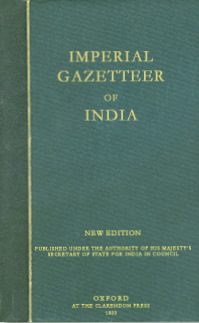The Imperial Gazetteer of India
Appearance

The Imperial Gazetteer of India was a gazetteer of the British Indian Empire, and is now a historical reference work. It was first published in 1881. Sir William Wilson Hunter made the original plans of the book, starting in 1869.
Quotes
[edit]- No very strict line can be drawn between Animists and low-class Hindus.
- "Imperial Gazetteer Of India Provincial Series Bombay Presidency Vol-i" [1]
- ...the wild jungle tribes in Central India, though the persons who profess the latter stoutly advance a claim to be considered Hindus.
- Imperial Gazetteer Of India United Provincre Of Agra And Oudh [2]
- 'It would be a mistake to suppose that Buddhism and Jainism were directed from the outset consciously in opposition to the caste system. Caste, in fact, at the time of the rise of Buddhism was only beginning to develop; and in later days, when Buddhism commenced its missionary careers, it took caste with it into regions where upto that time the institution had not penetrated.'
- Sir W.W. Hunter: W.W. Hunter: Imperial Gazetteer 1907; quoted in J. Kulkarni: Historical Truths, p.27.
- At one corner of a vast mound known as Ramkot, or the fort of Rama, is the holy spot where the hero was born. Most of the enclosure is occupied by a mosque built by Babar from the remains of an old temple, and in the outer portion a small platform and shrine mark the birth place.
- Imperial Gazetteer of India, Provincial Series, United Provinces of Agra and Oudh, Vol.II, pp 338-339. Quoted from Narain, Harsh (1993). The Ayodhya temple-mosque dispute: Focus on Muslim sources. Delhi: Penman Publishers. [3]
- If Ajodhya was then little other than a wilderness, it must at least have possessed a fine temple in the Janamasthan; for many of its columns are still in existence and in good preservation, having been used by the Musalmans in the construction of the Babari Mosque. These are of strong, close- grained, darkcolored or black stone called by the natives kasauti and carved with different devices
- (Benett 1877-78 :6-7). Gazetter of Oudh, in Jain, M. (2017). The battle of Rama: Case of the temple at Ayodhya. ch 3
- Firoz Tughlak, foiled in his attempt to seize' Khargu, who fled to Kumaun, appointed an Afghan governor at Sambhal with orders to invade the country of Katehar every year, to commit every kind of ravage and devastation, and not to allow it to be inhabited until tire murderer was given up.
- quoted in Imperial Gazetteer Of India United Provincre Of Agra And Oudh [4] also in Lal, K. S. (1995). Growth of scheduled tribes and castes in medieval India.

